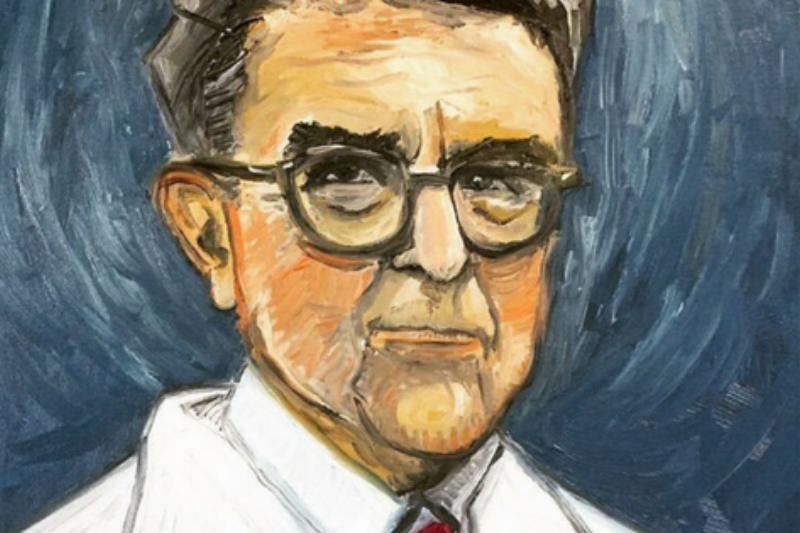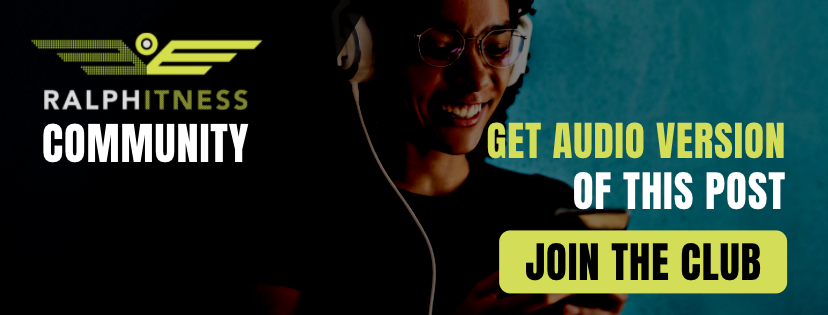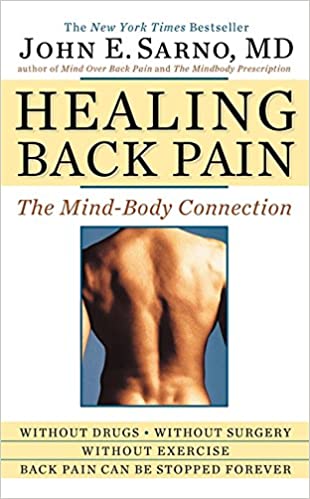
One of the things that is very common out there, even with Dr Sarno’s work, there are 10 daily reminders out there and it’s a list of things that you know some people recite over and over.
It’s a daily reminder or weekly reminder that the pain is psychosomatic and that it’s not really in the body, etc.
Don’t be afraid of it and all that good stuff, but once we turn anything into a ritual including re-reading the book, so we’re going to read the book and we’re going to analyze it.
Daily Rituals: The Three Things Dr. Sarno tells in this book?

Starting from the very first page inside the book, Dr Sarno tells his tms patients:
Number one: Resume physical activity, it won’t hurt you
Number two: Talk to your brain. Tell it you won’t take it anymore.
Number three: Stop all physical treatments for your back. They may be blocking your recovery.
What does stopping physical treatments mean?
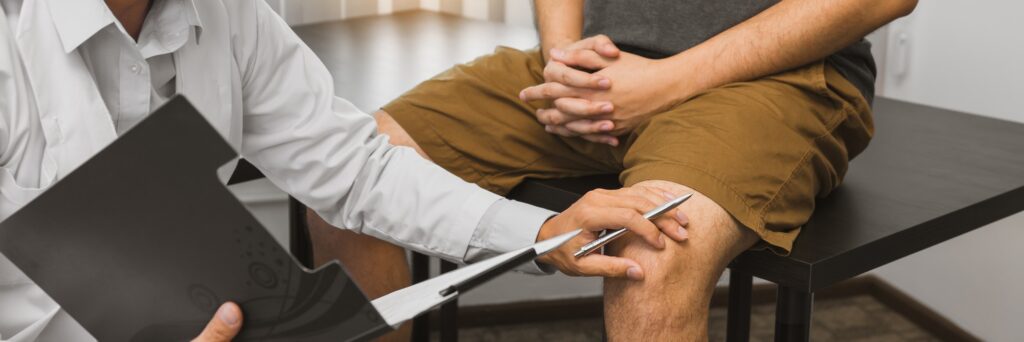
Stopping all physical treatments for your back doesn’t mean get off of your medication. It doesn’t say stop taking your humera or any biologics that you may be taking for back pain.
It simply says physical treatments. What he’s referring to are things, like special stretches, special physical routines with the intentions of eliminating your back pain.
The kicker physical activity does help to a certain extent, but the intention behind the physical, like the physical activity is extremely important.
How does exercise help?

We’re going to explore why exercise helps, how it helps exactly and how it is still connected to the mind body connection.
So, if your intention is let me do special exercises and eliminate my back pain that can potentially backfire. If your intention is let me do some physical exercises and get in shape or practice a new sport that can be very beneficial in your favor.
Obviously you still want to take precautions and not do exercises that you’re not ready to do yet as any normal human being would but it’s important to know the difference there.
The Three Key Recommendations of Dr. Sarno

We will try to go into further details as we continue. The three things that Dr Sarno recommends you don’t do and this is reading from the book now.
Number one: Don’t repress your anger or emotions. They can give you a pain in the back, that’s the very first thing he says.
Number two: Don’t think of yourself as being injured psychological conditioning which contributes to ongoing back pain.

Number three: Don’t be intimidated by back pain. You have the power to overcome it using the actual case study case histories of his own patients Dr John Sarno shows why tension and unexpressed emotions particularly anger cause chronic back pain and how awareness and understanding are the first steps to doing something about it.
Physical treatments and back-pain relief
Massage
You may wonder does the massage count as a physical treatment to relieve the pain. Yes, it does. There is one thing I want to make clear first.
Don’t just stop the massages out of nowhere.
If you wish you can gradually work your way out of it and yes it does slow down your healing but I don’t recommend stopping everything immediately.
What are Dr. Sarno’s thoughts about massage?
Dr Sarno says you have to be careful with psychological conditioning and it’s true but if you’re already conditioned to getting a massage every Tuesday at four o’clock.
Just to help your back pain gradually, you can go maybe once a week and then make it bi-weekly, then make it once a month and then eventually once every two months or so on.
Until the massage is intended to relieve the back pain, you have to be careful with that if you just want to go to a spa and make it a self-care practice definitely go for it. Enjoy your massages.
Yoga practices?

Another question can be whether daily yoga practice be considered a physical treatment? Yes, if the intention is to get rid of the back pain with a yoga practice.
You need to be careful with that. There are plenty of people out there that have started a yoga practice and have found relief. Some have gone into full remission so i’m not saying that yoga won’t help you but it will.
The important thing is what’s the intention behind it.
If you just so happen to be on your healing journey and you just had an awakening and you realized something about the universe and the nature of your mind and yoga became your spiritual practice or just became a form of exercise or just for whatever reason it caught your attention and it became something that you just started doing just because you have genuine interest in it, then yes that can be a lot more therapeutic than doing yoga because you have to get rid of your back pain.
Meditation
The same is true for things like meditation.
So a question that I am asked a lot is should I meditate? Do I have to meditate? The answer is if the intention is to get rid of the back pain, you get to be careful with that.
Now if you’ve always been the type of person that has been interested in meditating and that’s just been your thing then it’s irrelevant.
That’s just a thing that you do but if you’ve never meditated, it’s never been your thing and then all of a sudden, you heard somewhere in the internet that meditation is going to relieve your back pain and you’re starting to meditate that can backfire against you.
If let’s say swimming was your thing instead of meditation. Swimming would actually be more therapeutic than meditation simply because it’s closer to something that brings you joy. It’s closer to something that is more related to your genuine interests.
One may ask what if you begin meditation to heal but you now want to do it because you love it yes that’s beneficial so if what brought you to meditation was the pain but then eventually at some point you just realized hey, I actually enjoy this thing then yeah that’s perfectly fine.
But if you’re having a rough day and you call your masseuse and your masseuse says I am sorry man I am booked today and you have a feeling of tension, a feeling in your body and you have to hurry up and meditate because you need to calm yourself down.
That’s where the thin line is between being on a healing journey that is actually going to help you improve versus being on a healing journey that isn’t quite intolerable.
Talking to your brain
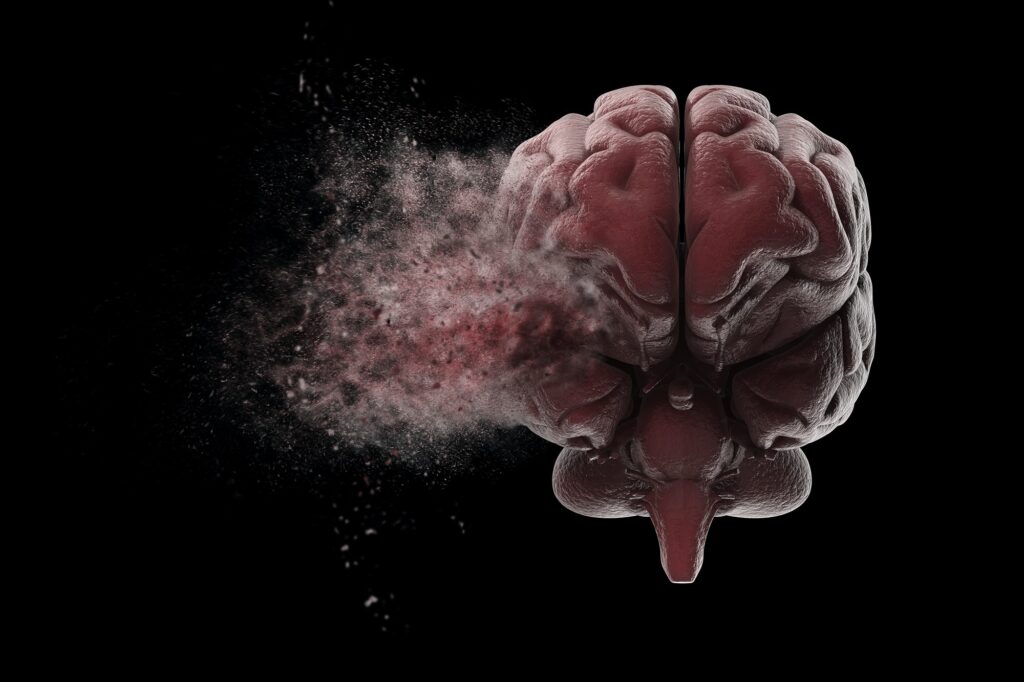
Talking to your brain has been helpful for many, like repeating to ownself that I’m not going to take this anymore. Yes, It’s a strange practice, but it can be helpful definitely.
I agree and yes, it could be a little strange at first but it’s it’s not something you’ll be doing forever. Eventually you’ll just forget and move on.
Dr Sarno and the Treatment of Back Pain!
As early as 1965 because of my medical specialty, physical medicine and rehabilitation and as director of outpatient services at Rusk Institute of Rehabilitation Medicine, I cared for a greater than average number of patients with pain disorders, the majority with back pain.
Dr Sarno’s job was helping people with back pain. His specialty was in physical medicine and rehabilitation and a vast majority of his patients were people with back pain.
This is very important because nowadays you can be a chiropractor ( no offense to anyone or anyone who sees a chiropractor ) but you can call yourself a doctor. You can have a degree in something else and call yourself doctor.
But if we’re reading a book about healing back pain written by a person that was a doctor on rehabilitation and specializing in people with back pain, it’s interesting that you may find some people that disagree with Dr Sarno.
They don’t believe it but I personally and everyone could have their own opinion but I personally have the tendency to have more faith in the person who’s been doing healing the back pain stuff or addressing physical injuries for a long time and especially someone who has put in the time in school and has been educated on the matter.
It’s very rare to have a professional, be educated to do things a certain way and then suddenly realize that the way he was taught necessarily the way that it actually is now moving on. It says treating back pain was frustrating and depressing for me as I could never predict the outcome as a physician keen on accurate diagnosis and treatment.
Over the years I became increasingly troubled with the fact that frequently the pattern of a patient’s pain and the findings on physical examination didn’t match the presumed pathology.
The pain, for example, might be attributed to radiographic findings of degenerative arthritis of the joints of the last lumbar vertebrae.
The lumbar is the lower part of your spine so your back has a bone in the middle and the very last part at the bottom is the lumbar spine. It’s just above sacrum, right around the hip but the patient often had pain in places that had nothing to do with these joints.
My classical medical training taught me to consider back pain as, primarily, due to structural abnormalities of the spine, most commonly arthritic or disc disorders or the result of poor posture. Public opinion reinforces the belief that poor posture gives you back pain compression of nerves or lack of exercise.
I simply treated patients in accordance with traditional medical training in the early 1970s.
I began to notice that the outcomes of patients with the same physical findings seemed more dependent on the degree of their faith in me as their physician rather than the physical treatment.
I was admitted ministering early 1970s and this book was first published in 1991 so that’s about give or take about 30 years of experience before this book was written by someone who was doing this pretty much every single day.
I began to think that back pain was psychosomatic, particularly as most of the patients I saw had a history of other psychosomatic manifestations.
What does Psychosomatic mean?

The word psychosomatic itself is a word that I have gotten a lot of questions on. I have gotten a lot of insults on and a lot of confused people because there’s an assumption that psychosomatic means that it’s all in your head. That’s not what psychosomatic means.
The first part of the word psychosomatic is the root word psych. As psyche is in reference to the mind the original meaning of the word psyche was in reference to the spirit mind spirit we can get really philosophical about what is it actually?
Is it spiritual suffering or is it psychological suffering behind the pain but for now just breaking down the word itself, psych in reference to the mind and soma is in reference to the body, so putting it together psychosomatic is a physical experience with roots in the mind or in the spirit; however which way you wish to see it now there are many psychosomatic experiences that we have on the daily basis that aren’t necessarily diseases, for example, if you’re walking down the street you trip over a rock and you bang your knee depending on who you are. You might hold your knee and cry about it and as you’re crying about it a tear comes out of your eye right now we may say well of course that’s part of crying.
You hurt your knee, you cry and there’s the tear now what about if you’re at home sitting on the couch watching a movie and the movie was so beautiful was so amazing and it really just touched your heart and you’re crying watching this movie, there is an emotional experience that was triggered or influenced by the things that you saw on the television that led you to have a physical response, such as a tear coming out of your eye based on as a result of what you were feeling.
The same is true when we imagine things when we start to imagine that if we’re running late to work or the boss is going to fire you or you’re going to get in trouble or something bad is going to happen to one of your loved ones, your body responds to that emotionally as if it was actually happening.
When these thoughts and these emotional experiences become chronic and they keep happening over and over and over, it’s only a matter of time before those little bits and and hints of tension that the body creates as a response to it.
The word psychosomatic means it’s a physical response rooted in the mind so the tears are real.
If you’re crying because you’re watching a movie those tears are real or if you’re crying because you’re imagining that something bad is going to happen those tears are real. It’s a real physical experience but the roots of it it’s in is psychological emotional does that make sense to everyone.
The theory of TMS
There is a new theory about the ideology of pain disorder that is called TMS for tension myositis syndrome treatment, which I have since more accurately labeled the tension myoneural syndrome attributing greater prominence to the prevalence of neural symptoms rather than the involvement of inflamed muscles.
So Dr Sarno more accurately renamed this tension myositis which originally meant tension in the muscles.
He renamed it tension myoneural syndrome in order to put more focus on the involvement of nerves so when you have back pain and you’re poking at it icing it etc because you feel the pain in the muscles.
The pain is actually in the nerve and we may think well, so it’s actually a form of nerve pain what about the inflammation and all that stuff and the degeneration etc.
TMS has more focus on the nerves as opposed to the muscle when it comes to the experience of pain moving on the theory that such a very physical condition as back pain could be psychosomatic flew in the face of convention. Dr Sarno has medical history himself and he too experienced some tms in his life just like everyone does as well as some psychosomatic experiences.
Dr Sarno experienced chronic migraines that was one of the things that he experienced and I highlighted this part because this is a man that is observing his own medical history, his own personality and of course at least 30 years of experience.
The observation of thousands of patients in pain and my experience during nine years as a family physician made me receptive to the idea I tested the theory by changing my treatment protocols and emphasizing the role of emotions in the cause of pain and there were obvious improvements in my patients, I could begin to predict which of them would do well and which would not.
After eight years approximately of seeing only people with back pain, no matter what it is tms, and closing spondylitis, I can do the same and I am not tooting my own horn but I can somewhat tell what are the signs of a person who’s gonna do well in the program and what are the signs of a person who will not.
That usually takes about 15 minutes of just a regular brief conversation before those signs start to come up obviously. There are some traits that we can kind of work around and help the person become aware of that.
That can become helpful in the long run but then there are some traits that that are extremely difficult out of all.
The personality traits that Dr Sarno points out in my personal experience goodism is probably one of the most difficult goodism especially if it has religious, some type of religion thing attached to it, goodism with religion seems for my experience to be one of one of the most challenging, when it comes to this.
I am not saying that there’s no hope, I am not saying you know that that’s it you’re screwed but what i am saying is that after seeing the same thing over and over you get to the point where you can pretty much get an idea of who’s who’s gonna do well and who might struggle.
This was an exciting development in how I treated and ultimately was able to help my patients in the 25 years since healing back pain was first published.
The incidence and impact of back pain has increased exponentially.
The statistics and data are astounding; over 100 million people are now affected at a total cost in the United States exceeding 100 billion dollars per year of which two-thirds is lost to wages and reduce productivity.
The 2010 global burden of disease study, study of 291 conditions, ranked low back pain as the highest cause of disability and sixth in terms of overall burden when measured in terms of years lived with disability.
The incidence of low back pain increased an estimated 43 percent between 1990 and 2010 leading to the prediction that living with disability will soon outnumber years of life lost to early death as the incidence of back pain increased the pharmacology.
The pharmacology industry introduced new opioid pain medications and quadrupled its sales of synthetic opiates.
This may have been partly driven by the industry but many patients have welcomed and encouraged it perhaps in response to the belief that modern medicine has the power to cure all illnesses or out of the wish to alleviate the desperation that results from the reality of living with chronic pain and disability.
Put simply, the chronic pain epidemic impacts the lives of individuals and families by adding in numerical physical and emotional challenges to the possibility of leading satisfied comfortable and contented lives
Goodest behavior:

Many suffer from goodest behavior.
There can be two questions:
1-Is that a trauma response to behaving that way to feel like it’s your responsibility to take on the problems of the world and resolve them.
That’s what a lot of mental health professionals say that goodism is a trauma response.
There are many trauma responses and goodism is one of them. If you have trauma or if you have a history of trauma, it’s beneficial to speak to a mental health professional, explore those traumas and heal as best as you can but it’s not a necessary thing for the pain to go away. That’s a common misconception that you have to heal the trauma for the pain to go away.
I still don’t understand how to resolve this behavior, the behavior of the pain, the behavior of goodism. I definitely understand the connection of it to the pain but I don’t know how to resolve this behavior.
What is Radical Acceptance?
If you are uncomfortable with what you’re experiencing and rather than fight it and get overwhelmed, if it’s possible to say I don’t like this stuff and and yet at the same time it is what it is and just to be able to hold that along with your disgust or whatever like to be able to name your emotions to be able to feel those emotions and to also somehow just just look at the situation knowing that you know time will pass and you can’t save the world right now.
You don’t need to go into details but this constant radical acceptance you can look at it and you just have to accept the reality of the situation whether or not you like it. Not liking it doesn’t mean you can’t accept it.
When we’re talking about radical acceptance we’re not going to say okay I accept the situation and the media; we also have to accept your part in this.
You are able to speak your truth about the situation even though it’s not going to change the world. It’s valid to feel like you want to do something and you know you’re powerless and you feel vulnerable.
To have an emotional reaction to something and to feel empathy is valid and probably healthy but it’s more the repression.
There is also a healthy goodist. If you see on the news somebody died and you feel it all of a sudden, just like oh my god somebody died. I don’t have any connection to this person but as opposed my friend doesn’t care if somebody died. He has a different temperament. I have a tendency to feel things.
You can lessen this strain that you’re under in that moment with radical acceptance by observing the fact that you’re having this sort of reaction is healthy. Radical acceptance doesn’t mean you have to set the world exactly as it is.
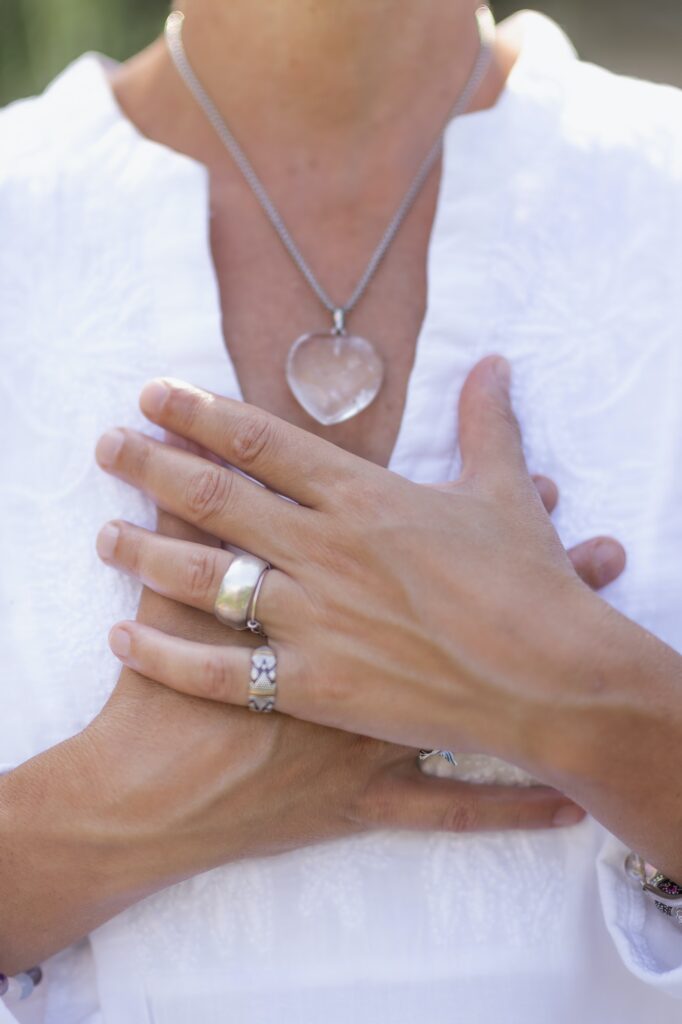
Radical acceptance first starts with you. You have to accept you first so if if a part of you turns on the tv and sees all this stuff going on and what you want to say is WTF is this but there you are at the same time, being a goodist, you watch your language. I don’t know what people are going to think about this.
How do you make peace and then the anxiety goes on from there and the torment goes on from there so initially. That keeps you anxious and thinking how are people going to perceive you and will start making judgments and and talking to themselves in their own heads, like that person is such a potty mouth.
They can think whatever they want to think but the instinct they decide to move away from the group or move away from you because you said something that they disagree with now they just reinforced.
We can have a really heated debate with our friends and express what we want to express just like they do in the house of representatives.
They’re all there always arguing with each other but at the end of the debate they shake their hands. It’s all politics at the end of the day.
We can do the same thing. We can learn how to sit with the uncomfortable conversation because if we can’t do that then we’re reinforcing the behavior of avoiding situations like these heated situations and that further reinforces your goodism, it further reinforces whatever fuels your pain.
If you want to give your input or share thoughts, you can join the club.
You are free to ask anything.
Have a good time and enjoy life.

